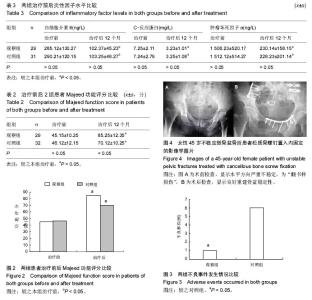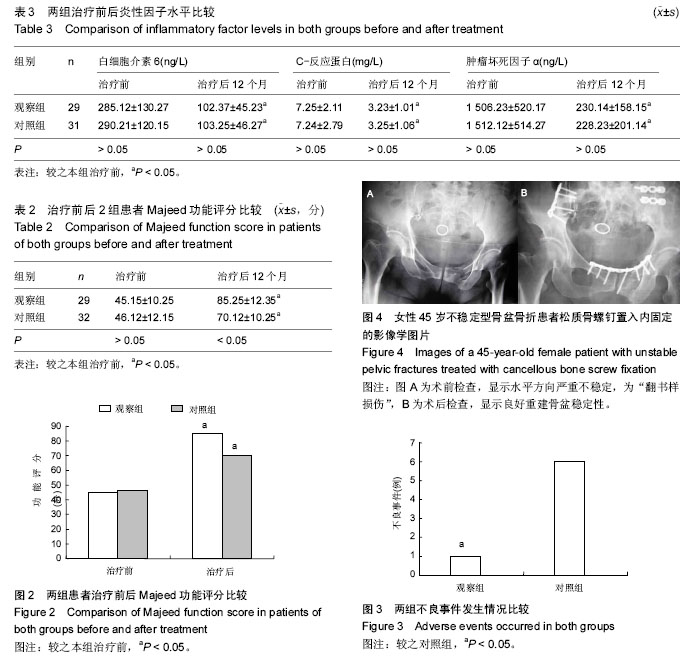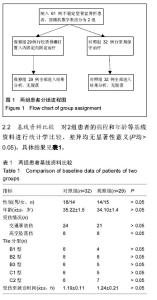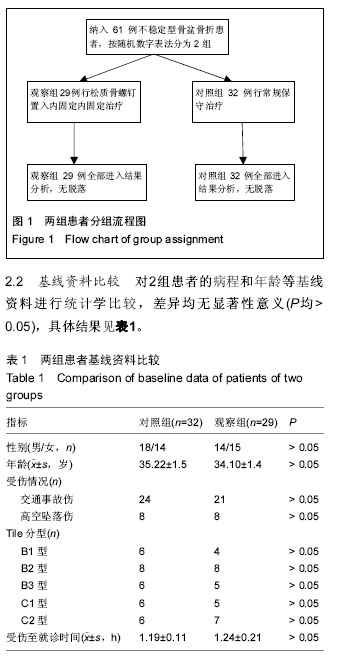Chinese Journal of Tissue Engineering Research ›› 2016, Vol. 20 ›› Issue (22): 3272-3278.doi: 10.3969/j.issn.2095-4344.2016.22.011
Previous Articles Next Articles
Unstable pelvic fractures treated with cancellous bone screw fixation: inflammatory factor levels
Xu Meng-fan, Zhuang Huan-xiong, Mai Hu-qiang, Chen Shi-xiong
- Department of Orthopedics, Dongfang People’s Hospital, Dongfang 572600, Hainan Province, China
-
Revised:2016-04-11Online:2016-05-27Published:2016-05-27 -
About author:Xu Meng-fan, Associate chief physician, Department of Orthopedics, Dongfang People’s Hospital, Dongfang 572600, Hainan Province, China
CLC Number:
Cite this article
Xu Meng-fan, Zhuang Huan-xiong, Mai Hu-qiang, Chen Shi-xiong. Unstable pelvic fractures treated with cancellous bone screw fixation: inflammatory factor levels[J]. Chinese Journal of Tissue Engineering Research, 2016, 20(22): 3272-3278.
share this article

2.3 治疗前后两组患者Majeed功能评分比较 治疗前和末次随访,分别评估2组患者Majeed功能评分,可得较之本组治疗前,2组评分均显著上升(P均< 0.05)。且治疗后12个月Majeed功能评分比较,对照组显著低于观察组(P < 0.05),见表2及图2。 2.4 两组患者治疗前后不同炎性因子水平比较 治疗前后,分别对两组进行炎性因子水平检测,可得较之本组治疗前,2组患者的白细胞介素6、C-反应蛋白、肿瘤坏死因子α水平均出现显著下降的情况(P均< 0.05);但2组患者治疗前后进行组间比较,各指标差异均无显著性意义(P > 0.05),具体结果如表3所示。 2.5 不良事件发生情况 术后1例观察组患者出现切口感染;对照组则有4例患者出现切口感染现象,1例出现骨不连,1例出现骨坏死。上述患者均及时接受对症处理,并痊愈,未出现死亡病例。2组的不良事件发生情况差异有显著性意义(P < 0.05),见图3。 2.6 典型病例 患者,女,45岁,车祸导致不稳定型骨盆骨折,水平方向严重不稳定,为“翻书样损伤”(见图4A)。征得患者及其家属知情同意,实施松质骨螺钉置入内固定治疗。手术时间40 min,无血管神经副损伤,手术相关出血10 mL,螺钉相关切口2 cm,术后疼痛立刻消失,24 h后床上自主翻身正常。术后检查,显示良好重建骨盆稳定性(见图4B)。术后骨折愈合满意,患者恢复行走能力。术后随访12个月,患者功能恢复良好,炎性因子水平正常。"

| [1] 宋连新,张英泽,彭阿钦,等.垂直不稳定性骨盆骨折内固定的生物力学研究[J].中华实验外科杂志,2000,17(2): 126-127. [2] 游小军.经皮微创空芯加压螺钉内固定术治疗TileCl型骨盆骨折临床观察[J].山东医药,2011,51(19):50-51. [3] 苏柯,刘颖,彭阿钦,等.1枚与2枚骶髂螺钉固定Tile C1型骨盆骨折的稳定性比较[J].中华创伤杂志,2012,28(3): 246-249. [4] 王军强,赵春鹏,苏永刚,等.透视影像导航经皮螺钉内固定治疗不稳定骨盆骨折的初步报告[J].中华创伤骨科杂志, 2009,11(7):603-608. [5] Metsemakers WJ,Vanderschot P, Jennes E, et al. Transcatheter embolotherapy after external surgical stabilization is a valuable treatment algorithm for patients with persistent haemorrhage from unstable pelvic fractures: Outcomes of a single centre experience. Injury. 2013;44(7):964-968. [6] Chao NS, Liu CS, Chung KL, et al. Retroperitoneal pelvic packing for haemodynamically unstable pelvic fractures in children and adolescents: A level-one trauma-centre experience. J Pediatr Surg. 2012;47(12): 2244-2250. [7] 章银灿,楼才俊,方伟松,等. 重型不稳定骨盆骨折的治疗[A];全国中西医结合学会骨伤科专业委员会第十二次学术年会浙江省中西医结合学会骨伤科专业委员会第十次学术年会论文汇编[C],2004年. [8] 郝钊,郝剑,曾国庆,等.经皮骶髂螺钉与骶髂关节前方钢板固定治疗 Tile C型骨盆骨折的疗效比较[J].中国临床医生,2014,(9):49-50. [9] Osborn PM,Smith WR,Moore EE,et al.Direct retroperitoneal pelvic packing versus pelvic angiography: A comparison of two management protocols for haemodynamically unstable pelvic fractures. Injury. 2009;40(1):54-60. [10] Nunn T,Cosker TD,Bose D,et al.Immediate application of improvised pelvic binder as first step in extended resuscitation from life-threatening hypovolaemic shock in conscious patients with unstable pelvic injuries. Injury. 2007;38(1):125-128. [11] 宋连新,张英泽,潘进社,等.垂直不稳定骨盆骨折的手术治疗[J].中国矫形外科杂志,2000,7(1):11-12. [12] 周倬瑜,丁焕文,谢琦,等.旋转和垂直不稳定型骨盆骨折临床特点与治疗方法探讨[J].中国临床解剖学杂志,2003, 21(4):381-383. [13] 贾燕飞,冯卫.81例垂直不稳定骨盆骨折的手术治疗[J].内蒙古医学杂志,2007,39(5):564-566,封4. [14] 丁克海,孙月柏,王庆刚,等.切开复位内固定治疗不稳定骨盆骨折24例[J].交通医学,2007,21(6):699-701. [15] 朱贤友,孟双全,路续超,等.经皮骶髂关节螺钉治疗后骨盆骨折脱位的疗效[J].中国社区医师(医学专业),2011, 13(33): 74. [16] 邓少林,潘显明,马泽辉,等.经皮空心拉力螺钉结合外固定架治疗C1型骨盆骨折初步临床分析[J].西南国防医药, 2008,18(6):884-885. [17] 高伟强,王光林,刘华渝,等.经皮骶髂螺钉固定技术治疗不稳定骨盆骨折的疗效评价[J].中国修复重建外科杂志, 2008,22(3):321-323. [18] Oêtoole RV, Dancy L, Dietz AR, et al.Diagnosis of femoral neck fracture associated with femoral shaft fracture: Blinded comparison of computed tomography and plain radiography. J Orthop Trauma. 2013;27(6): 325-330. [19] Henes FO, Nüchtern JV, Groth M, et al. Comparison of diagnostic accuracy of Magnetic Resonance Imaging and Multidetector Computed Tomography in the detection of pelvic fractures.Eur J Radiol. 2012;81(9):2337-2342. [20] Prieto-Alhambra D, Avilés FF, Judge A, et al. Burden of pelvis fracture: A population-based study of incidence, hospitalisation and mortality. Osteoporos Int. 2012; 23(12):2797-2803. [21] Adams JM,Bilaniuk JW,Difazio LT,et al.Standard computed tomography of the chest, abdomen, and pelvis is sensitive and cost-effective for the detection of fractures of the shoulder girdle. Am Surg. 2011;77(9): 1183-1187. [22] 赵艳.螺钉与钢板在骨盆骨折置入内固定应用中的生物力学评价[J].中国组织工程研究与临床康复,2011,15(48): 9070-9073. [23] Smith WR, Moore EE, Osborn P. Retroperitoneal packing as a resuscitation technique for hemodynamically unstable pelvic fractures:report of two cases and description of technique. J Trauma. 2005;59(6):1510-1514. [24] Zwingmann J, Südkamp NP, König B, et al. Intra- and postoperative complications of navigated and conventional techniques in percutaneous iliosacral screw fixation after pelvic fractures: Results from the German Pelvic Trauma Registry. Injury. 2013;44(12):1765-1772. [25] Pang X, Huang Y. Physical Properties of Nano-HAs/ZrO 2 Coating on Surface of Titanium Materials Used in Dental-Implants and Its Biological Compatibility. J Nanosci Nanotechnol. 2012;12(2):902-910. [26] 宋世锋,彭磊,肖海涛,等.经皮骶髂螺钉与骶髂关节前方钢板固定治疗不稳定性骨盆骨折的对比研究[J].中华骨科杂志,2011,31(11):1191-1196. [27] 代飞,王序全,许建中,等.C形臂引导下经皮骶髂螺钉固定治疗C型骨盆骨折[J].重庆医学,2007,36(11):1026-1027,1030. [28] Cheuk KK, Li BS, Lam JW, et al. Synthesis, chain helicity, assembling structure, and biological compatibility of poly(phenylacetylene)s containing L-alanine moieties. Macromolecules. 2008;41(16): 5997-6005. [29] Raobaikady R, Redman J. Ball JA. Use of activated recombinant coagulation factor Ⅶ in patients undergoing reconstruction surgery for traumatic fracture of pelvis or pelvis and acetabulum:a double-blind,randomized,placebo-controlled trial. Br J Anaesth. 2005;94(5):586-591. [30] 马俭凡,陈庆华,熊廷亮,等.改良透视法经皮骶髂螺钉固定治疗Tile C型骨盆骨折[J].中国综合临床,2015,31(8): 749-752. [31] Brown AL, Naha PC, Benavides-Montes V, et al. Synthesis, X-ray Opacity, and Biological Compatibility of Ultra-High Payload Elemental Bismuth Nanoparticle X-ray Contrast Agents. Chem Mat. 2014;26(7): 2266-2274. [32] 韦建勋,梁斌,丘德赞,等.椎弓根螺钉结合髂骨螺钉治疗不稳定型骨盆骨折11例[J].广西医学,2012,34(8): 1034-1035. [33] 杨雷,王洪飞,王中海,等.经皮骶髂螺钉与骶髂关节前方钢板固定治疗不稳定性骨盆骨折的临床疗效分析[J].海南医学,2012,23(15):45-47. [34] Rozenstrauha I, Lodins E, Krage L, et al. Functional properties of glass-ceramic composites containing industrial inorganic waste and evaluation of their biological compatibility. Ceramics Int. 2013;39(7): 8007-8014. [35] Danti S, Ciofani G, Moscato S, et al.Boron nitride nanotubes and primary human osteoblasts: In vitro compatibility and biological interactions under low frequency ultrasound stimulation. Nanotechnology. 2013;24(46):465102-1-465102-13. [36] Majumder S,Roychowdhury A,Pal S,et al.Simulation of hip fracture in sideways fall using a 3D finite element model of pelvis-femur-soft tissue complex with simplified representation of whole body. Med Eng Phys. 2007;29(10):1167-1178. [37] Wong LC, Chiu WK, Russ M, et al. Review of techniques for monitoring the healing fracture of bones for implementation in an internally fixated pelvis. Med Eng Phys. 2012;34(2):140-152. [38] Lefaivre KA, Slobogean GP, Ngai JT, et al. What outcomes are important for patients after pelvic trauma? Subjective responses and psychometric analysis of three published pelvic-specific outcome instruments. J Orthop Trauma. 2014;28(1):23-27. [39] 孙旭,吴新宝,董翠鹰,等.骶髂关节螺钉手术治疗不稳定骨盆骨折42例结果分析[J].山东医药,2010,50(44):17-19. [40] 赵红卫,邹戟,肖运祥,等.重建钢板结合骶髂关节螺钉治疗复杂骶髂关节骨折脱位[J].实用医学杂志,2009,25(18): 3085-3086. |
| [1] | Shi Bin, An Jing, Chen Long-gang, Zhang Nan, Tian Ye . Influencing factors for pain after total knee arthroplasty [J]. Chinese Journal of Tissue Engineering Research, 2017, 21(7): 993-997. |
| [2] | Wang Xian-xun. Impact of local compression cryotherapy combined with continuous passive motion on the early functional recovery after total knee arthroplasty [J]. Chinese Journal of Tissue Engineering Research, 2017, 21(7): 998-1003. |
| [3] | Yuan Wei, Zhao Hui, Ding Zhe-ru, Wu Yu-li, Wu Hai-shan, Qian Qi-rong. Association between psychological resilience and acute mental disorders after total knee arthroplasty [J]. Chinese Journal of Tissue Engineering Research, 2017, 21(7): 1015-1019. |
| [4] | Chen Qun-qun, Qiao Rong-qin, Duan Rui-qi, Hu Nian-hong, Li Zhao, Shao Min. Acu-Loc®2 volar distal radius bone plate system for repairing type C fracture of distal radius [J]. Chinese Journal of Tissue Engineering Research, 2017, 21(7): 1025-1030. |
| [5] | Huang Xiang-wang, Liu Hong-zhe. A new low elastic modulus of beta titanium alloy Ti2448 spinal pedicle screw fixation affects thoracic stability: biomechanical analysis [J]. Chinese Journal of Tissue Engineering Research, 2017, 21(7): 1031-1035. |
| [6] | Xie Qiang. Three-dimensional finite element model for biomechanical analysis of stress in knee inversion and external rotation after posterior cruciate ligament rupture [J]. Chinese Journal of Tissue Engineering Research, 2017, 21(7): 1036-1040. |
| [7] | He Ze-dong, Zhao Jing, Chen Liang-yu, Li Ke, Weng Jie. Multilevel finite element analysis on the biological tribology damage of water on bone tissue [J]. Chinese Journal of Tissue Engineering Research, 2017, 21(7): 1041-1045. |
| [8] | Li Jing, Yang Long, Wang Jian-ji, Liu Qin, Zou Qiang, Sun Yu, Ma Min-xian, Ye Chuan. Three-dimensional reconstruction based on DICOM data and its application for orthopedic implants [J]. Chinese Journal of Tissue Engineering Research, 2017, 21(7): 1046-1051. |
| [9] | Jiang Zi-wei, Huang Feng, Cheng Si-yuan, Zheng Xiao-hui, Sun Shi-dong, Zhao Jing-tao, Cong Hai-chen,Sun Han-qiao, Dong Hang. Design and finite element analysis of digital splint [J]. Chinese Journal of Tissue Engineering Research, 2017, 21(7): 1052-1056. |
| [10] | Wang Fei, Liu Zhi-bin, Tao Hui-ren, Zhang Jian-hua, Li Chang-hong, Cao Qiang, Zheng Jun, Liu Yan-xiong, Qu Xiao-peng. Clinical efficacy of preoperative osteotomy designs using paper-cut technology versus photoshop software for ankylosing spondylitis with kyphosis [J]. Chinese Journal of Tissue Engineering Research, 2017, 21(7): 1057-1063. |
| [11] | Li Hui, Ma Jun-yi, Ma Yuan, Zhu Xu . Establishment of a three-dimensional finite element model of ankylosing spondylitis kyphosis [J]. Chinese Journal of Tissue Engineering Research, 2017, 21(7): 1069-1073. |
| [12] | Ling Guan-han, Ou Zhi-xue, Yao Lan, Wen Li-chun, Wang Guo-xiang, Lin Heng-feng. Establishment of simulating three-dimensional model of China-Japan Friendship Hospital Classification for L type osteonecrosis of the femoral head [J]. Chinese Journal of Tissue Engineering Research, 2017, 21(7): 1074-1079. |
| [13] | Fu Wei-min, Wang Ben-jie. Assessing the degree of necrotic femoral head, and association of blood supply with pathlogical changes: study protocol for a diagnostic animal trial [J]. Chinese Journal of Tissue Engineering Research, 2017, 21(7): 1086-1091. |
| [14] | Zhang Wen-qiang, Ding Qian, Zhang Na. Associations between alpha angle and herniation pit on oblique axial magnetic resonance imaging in asymptomatic hip joints of adults [J]. Chinese Journal of Tissue Engineering Research, 2017, 21(7): 1098-1103. |
| [15] | Sun Xiao-xin1, Zhou Wei2, Zuo Shu-ping3, Liu Hao1, Song Jing-feng1, Liang Chun-yu1. Morphological characteristics for the magnetic resonance imaging assessment of discoid lateral meniscal tears in children [J]. Chinese Journal of Tissue Engineering Research, 2017, 21(7): 1104-1109. |
| Viewed | ||||||
|
Full text |
|
|||||
|
Abstract |
|
|||||

